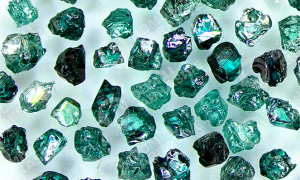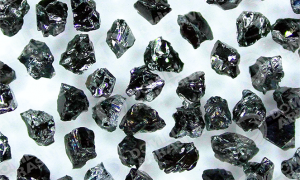Home / News & Blog / Abrasive Blog / Silicon Carbide Abrasive Grains: The All-Rounder in the Industry
Hey everyone, today I want to chat with you about silicon carbide (SiC) abrasive grains. As one of the hardest synthetic abrasives out there, silicon carbide holds a crucial place in the industrial world. Whether it`s grinding wheels, sandpaper, refractory materials, or sandblasting, its sharpness, thermal stability, and durability make it the go-to choice for many industries. So, what exactly are the uses of silicon carbide? And how does its quality impact performance? Let`s dive in and find out.


Silicon carbide is widely used in grinding wheels because of its extreme hardness and sharp cutting edges. While it`s a bit more delicate compared to aluminum oxide, it performs exceptionally well in specific scenarios.
Superior Cutting Efficiency: Perfect for hard and brittle materials like glass, ceramics, and carbide tools. For example, in precision grinding of optical glass, silicon carbide wheels can quickly remove material without causing cracks.
High Heat Resistance: Reduces thermal damage when grinding sensitive materials. For instance, when machining titanium alloys, silicon carbide wheels prevent material deformation caused by high temperatures.
Self-Sharpening Properties: The grains stay sharp even after breaking, ensuring consistent cutting performance. This means the wheel maintains its efficiency over long periods, reducing the need for frequent replacements.
For precision applications, many manufacturers prefer using silicon carbide in ceramic and resin-bonded wheels. It not only minimizes heat generation but also stays sharp longer, making it the gold standard for precision grinding. For example, in the aerospace industry, silicon carbide wheels are used for precision grinding of turbine blades, ensuring high accuracy and surface finish.
In industries like automotive, woodworking, and electronics, silicon carbide sandpaper is the top choice for fine finishing. Its unique properties include:
Sharp and Hard Grains: Easily cuts through paint, metal, and composites. For example, in automotive repair, silicon carbide sandpaper quickly removes old paint layers without damaging the underlying metal.
Versatility: Suitable for both dry and wet applications, especially waterproof sandpaper. In woodworking, it`s commonly used in wet sanding to reduce dust and improve surface smoothness.
Minimal Clogging: Essential for polishing and ultra-fine finishing. For instance, in polishing electronic components, silicon carbide sandpaper maintains high efficiency over time, reducing downtime caused by clogging.
In high-end automotive finishing, high-purity silicon carbide sandpaper is highly favored. It leaves a smoother surface, reducing the need for additional polishing, saving both time and effort. For example, luxury car brands like Porsche and BMW extensively use silicon carbide sandpaper for body surface treatment.
Thanks to its extreme hardness and cutting power, silicon carbide is an ideal choice for sandblasting. Its applications include:
Surface Cleaning: Efficiently removes rust, scale, and old coatings. For example, in ship repair, silicon carbide sandblasting quickly cleans hull surfaces of rust and marine growth.
Etching and Engraving: Commonly used in glass and stone processing for detailed and precise results. For instance, in artistic glasswork, silicon carbide sandblasting creates intricate patterns and textures.
Surface Preparation: Creates a uniform profile to enhance coating adhesion. For example, in automotive manufacturing, silicon carbide sandblasting is used for surface preparation before applying primer, ensuring strong bonding between the coating and metal substrate.
Many industries recycle silicon carbide blasting media multiple times due to its exceptional durability. Repeated use doesn`t significantly degrade performance, making it both eco-friendly and cost-effective. For example, in aerospace, silicon carbide blasting media can be reused up to 10 times, significantly cutting costs.
In the refractory industry, silicon carbide grains play a vital role. Their features include:
High Melting Point (Over 2700°C): Ideal for furnace linings, crucibles, and kiln furniture. For example, in steelmaking, silicon carbide refractory bricks withstand temperatures up to 1600°C, ensuring long-term furnace stability.
Excellent Thermal Conductivity: Reduces heat loss and improves energy efficiency. For instance, in glass manufacturing, silicon carbide kiln furniture ensures even heat distribution, guaranteeing consistent glass quality.
Corrosion and Oxidation Resistance: Performs exceptionally well in harsh industrial environments. For example, in the chemical industry, silicon carbide refractories resist acidic and alkaline gas corrosion, extending equipment lifespan.
The purity and grain size of silicon carbide directly impact refractory performance. Lower impurity levels mean longer-lasting refractory bricks, especially in industries like steel and glass. For example, high-purity silicon carbide bricks last 30% longer than standard ones.
Beyond traditional uses, silicon carbide is making waves in the semiconductor industry. SiC wafers, with their unique properties, are key materials for high-performance electronics:
High Thermal Conductivity: Helps dissipate heat in electronic devices, improving efficiency. For example, in 5G base stations, SiC wafers reduce temperature rise in power devices, ensuring stable operation.
Low Electrical Resistance: Ideal for power electronics in electric vehicles (EVs). For instance, Tesla`s inverters use SiC power modules, significantly boosting energy conversion efficiency.
Exceptional Mechanical Strength: Essential for precision microelectronics. For example, in smartphone chip manufacturing, SiC wafers withstand high-intensity processing, ensuring high chip yields.
As demand for efficient electronics grows, silicon carbide is gradually replacing traditional silicon in semiconductors. Its role in polishing and finishing high-tech components is also becoming increasingly important. For example, in SiC wafer polishing, high-purity silicon carbide abrasives achieve surface roughness below 0.5 nanometers, meeting the demands of advanced chip manufacturing.
The performance of silicon carbide abrasives largely depends on purity, grain shape, and manufacturing processes. At DOMILL, we always ensure:
Low Impurities: Consistent chemical composition and performance. For example, our silicon carbide abrasives have impurity levels below 0.1%, far exceeding industry standards.
Uniform Grain Size: Reliable and predictable grinding and blasting results. For instance, our product grain size distribution is controlled within ±5%, ensuring batch-to-batch consistency.
Excellent Self-Sharpening Properties: Enhanced durability and cutting efficiency. For example, even after extended use, our silicon carbide abrasives maintain over 80% cutting efficiency.
Silicon carbide abrasive grains, with their hardness, thermal stability, and cutting efficiency, are indispensable across multiple industries. Whether it`s grinding, polishing, sandblasting, or high-temperature applications, their unique properties deliver exceptional performance and cost-effectiveness.
If you`re looking for high-purity, industrial-grade silicon carbide, DOMILL offers top-quality SiC products. Whether it`s bulk purchasing or sample testing, we`re here to support you. Feel free to reach out to us anytime to learn more!